remove seats FIAT TALENTO 2020 Owner handbook (in English)
[x] Cancel search | Manufacturer: FIAT, Model Year: 2020, Model line: TALENTO, Model: FIAT TALENTO 2020Pages: 236, PDF Size: 4.86 MB
Page 29 of 236
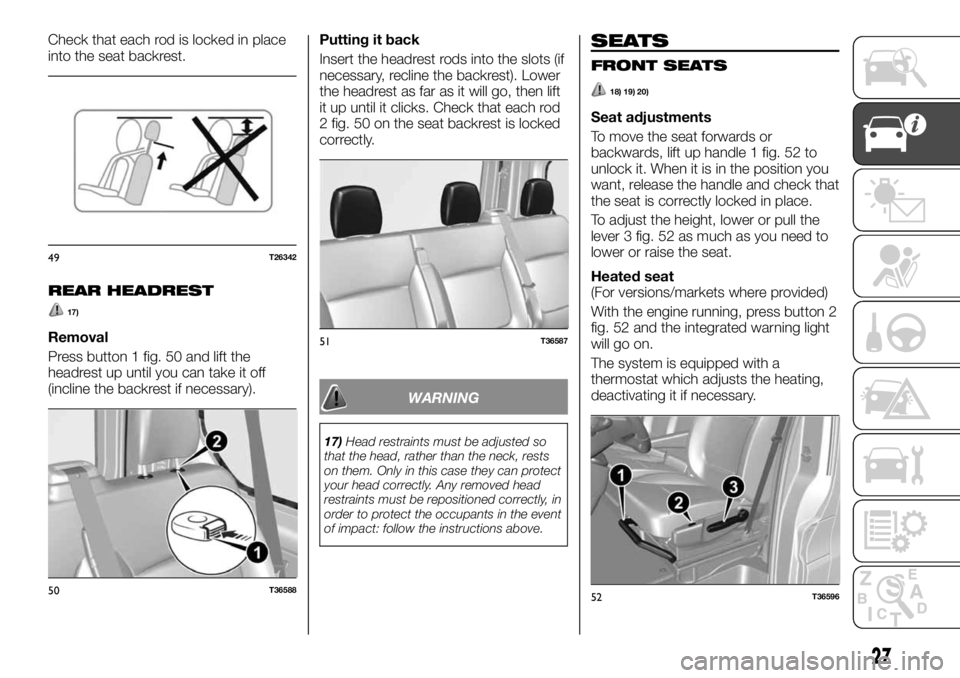
Check that each rod is locked in place
into the seat backrest.
REAR HEADREST
17)
Removal
Press button 1 fig. 50 and lift the
headrest up until you can take it off
(incline the backrest if necessary).Putting it back
Insert the headrest rods into the slots (if
necessary, recline the backrest). Lower
the headrest as far as it will go, then lift
it up until it clicks. Check that each rod
2 fig. 50 on the seat backrest is locked
correctly.
WARNING
17)Head restraints must be adjusted so
that the head, rather than the neck, rests
on them. Only in this case they can protect
your head correctly. Any removed head
restraints must be repositioned correctly, in
order to protect the occupants in the event
of impact: follow the instructions above.
SEATS
FRONT SEATS
18) 19) 20)
Seat adjustments
To move the seat forwards or
backwards, lift up handle 1 fig. 52 to
unlock it. When it is in the position you
want, release the handle and check that
the seat is correctly locked in place.
To adjust the height, lower or pull the
lever 3 fig. 52 as much as you need to
lower or raise the seat.
Heated seat
(For versions/markets where provided)
With the engine running, press button 2
fig. 52 and the integrated warning light
will go on.
The system is equipped with a
thermostat which adjusts the heating,
deactivating it if necessary.
49T26342
50T36588
51T36587
52T36596
27
Page 32 of 236
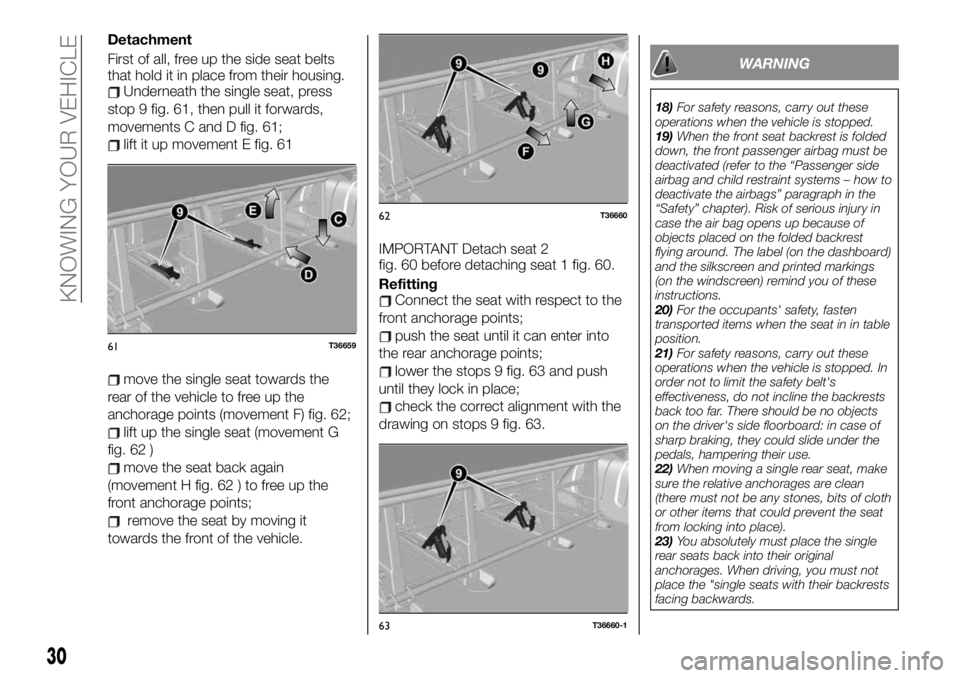
Detachment
First of all, free up the side seat belts
that hold it in place from their housing.
Underneath the single seat, press
stop 9 fig. 61, then pull it forwards,
movements C and D fig. 61;
lift it up movement E fig. 61
move the single seat towards the
rear of the vehicle to free up the
anchorage points (movement F) fig. 62;
lift up the single seat (movement G
fig. 62 )
move the seat back again
(movement H fig. 62 ) to free up the
front anchorage points;
remove the seat by moving it
towards the front of the vehicle.IMPORTANT Detach seat 2
fig. 60 before detaching seat 1 fig. 60.
Refitting
Connect the seat with respect to the
front anchorage points;
push the seat until it can enter into
the rear anchorage points;
lower the stops 9 fig. 63 and push
until they lock in place;
check the correct alignment with the
drawing on stops 9 fig. 63.
WARNING
18)For safety reasons, carry out these
operations when the vehicle is stopped.
19)When the front seat backrest is folded
down, the front passenger airbag must be
deactivated (refer to the “Passenger side
airbag and child restraint systems – how to
deactivate the airbags” paragraph in the
“Safety” chapter). Risk of serious injury in
case the air bag opens up because of
objects placed on the folded backrest
flying around. The label (on the dashboard)
and the silkscreen and printed markings
(on the windscreen) remind you of these
instructions.
20)For the occupants' safety, fasten
transported items when the seat in in table
position.
21)For safety reasons, carry out these
operations when the vehicle is stopped. In
order not to limit the safety belt's
effectiveness, do not incline the backrests
back too far. There should be no objects
on the driver's side floorboard: in case of
sharp braking, they could slide under the
pedals, hampering their use.
22)When moving a single rear seat, make
sure the relative anchorages are clean
(there must not be any stones, bits of cloth
or other items that could prevent the seat
from locking into place).
23)You absolutely must place the single
rear seats back into their original
anchorages. When driving, you must not
place the "single seats with their backrests
facing backwards.
61T36659
62T36660
63T36660-1
30
KNOWING YOUR VEHICLE
Page 94 of 236
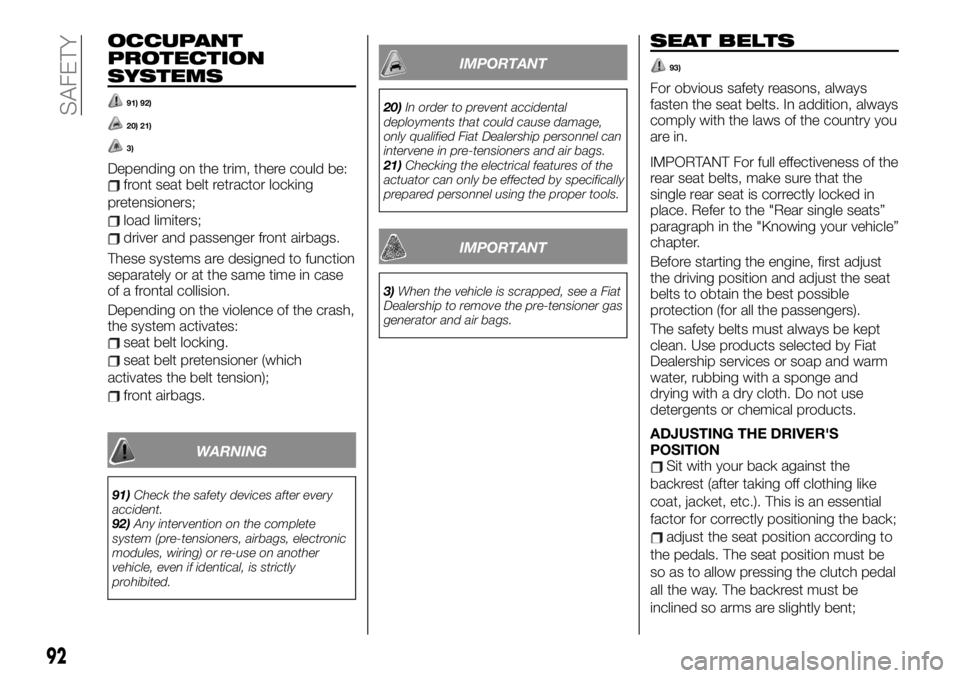
OCCUPANT
PROTECTION
SYSTEMS
91) 92)
20) 21)
3)
Depending on the trim, there could be:front seat belt retractor locking
pretensioners;
load limiters;
driver and passenger front airbags.
These systems are designed to function
separately or at the same time in case
of a frontal collision.
Depending on the violence of the crash,
the system activates:
seat belt locking.
seat belt pretensioner (which
activates the belt tension);
front airbags.
WARNING
91)Check the safety devices after every
accident.
92)Any intervention on the complete
system (pre-tensioners, airbags, electronic
modules, wiring) or re-use on another
vehicle, even if identical, is strictly
prohibited.
IMPORTANT
20)In order to prevent accidental
deployments that could cause damage,
only qualified Fiat Dealership personnel can
intervene in pre-tensioners and air bags.
21)Checking the electrical features of the
actuator can only be effected by specifically
prepared personnel using the proper tools.
IMPORTANT
3)When the vehicle is scrapped, see a Fiat
Dealership to remove the pre-tensioner gas
generator and air bags.
SEAT BELTS
93)
For obvious safety reasons, always
fasten the seat belts. In addition, always
comply with the laws of the country you
are in.
IMPORTANT For full effectiveness of the
rear seat belts, make sure that the
single rear seat is correctly locked in
place. Refer to the "Rear single seats”
paragraph in the "Knowing your vehicle”
chapter.
Before starting the engine, first adjust
the driving position and adjust the seat
belts to obtain the best possible
protection (for all the passengers).
The safety belts must always be kept
clean. Use products selected by Fiat
Dealership services or soap and warm
water, rubbing with a sponge and
drying with a dry cloth. Do not use
detergents or chemical products.
ADJUSTING THE DRIVER'S
POSITION
Sit with your back against the
backrest (after taking off clothing like
coat, jacket, etc.). This is an essential
factor for correctly positioning the back;
adjust the seat position according to
the pedals. The seat position must be
so as to allow pressing the clutch pedal
all the way. The backrest must be
inclined so arms are slightly bent;
92
SAFETY
Page 101 of 236
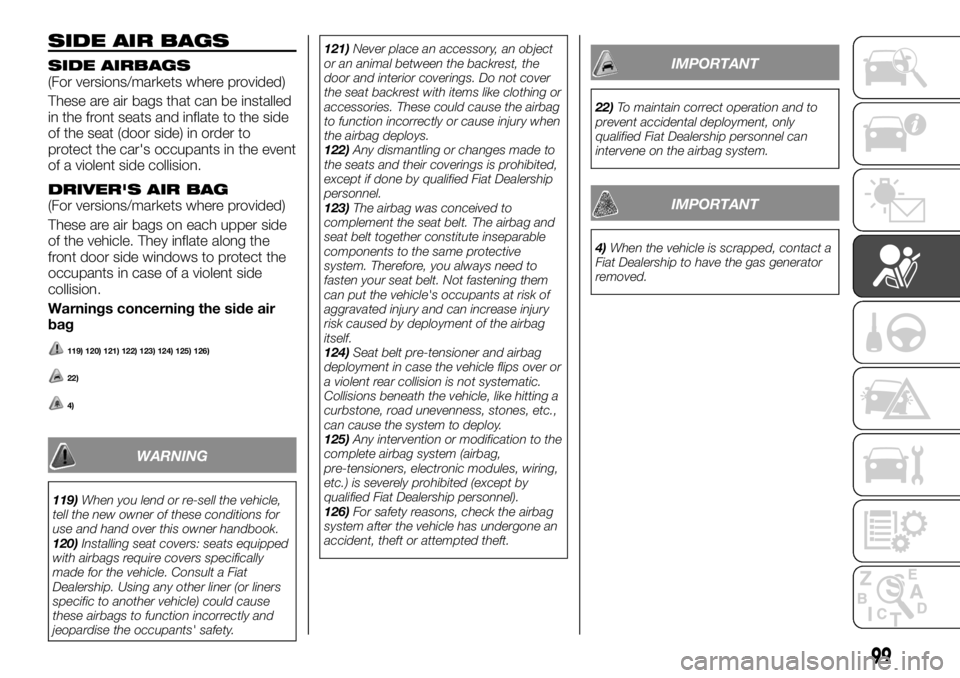
SIDE AIR BAGS
SIDE AIRBAGS(For versions/markets where provided)
These are air bags that can be installed
in the front seats and inflate to the side
of the seat (door side) in order to
protect the car's occupants in the event
of a violent side collision.
DRIVER'S AIR BAG(For versions/markets where provided)
These are air bags on each upper side
of the vehicle. They inflate along the
front door side windows to protect the
occupants in case of a violent side
collision.
Warnings concerning the side air
bag
119) 120) 121) 122) 123) 124) 125) 126)
22)
4)
WARNING
119)When you lend or re-sell the vehicle,
tell the new owner of these conditions for
use and hand over this owner handbook.
120)Installing seat covers: seats equipped
with airbags require covers specifically
made for the vehicle. Consult a Fiat
Dealership. Using any other liner (or liners
specific to another vehicle) could cause
these airbags to function incorrectly and
jeopardise the occupants' safety.121)Never place an accessory, an object
or an animal between the backrest, the
door and interior coverings. Do not cover
the seat backrest with items like clothing or
accessories. These could cause the airbag
to function incorrectly or cause injury when
the airbag deploys.
122)Any dismantling or changes made to
the seats and their coverings is prohibited,
except if done by qualified Fiat Dealership
personnel.
123)The airbag was conceived to
complement the seat belt. The airbag and
seat belt together constitute inseparable
components to the same protective
system. Therefore, you always need to
fasten your seat belt. Not fastening them
can put the vehicle's occupants at risk of
aggravated injury and can increase injury
risk caused by deployment of the airbag
itself.
124)Seat belt pre-tensioner and airbag
deployment in case the vehicle flips over or
a violent rear collision is not systematic.
Collisions beneath the vehicle, like hitting a
curbstone, road unevenness, stones, etc.,
can cause the system to deploy.
125)Any intervention or modification to the
complete airbag system (airbag,
pre-tensioners, electronic modules, wiring,
etc.) is severely prohibited (except by
qualified Fiat Dealership personnel).
126)For safety reasons, check the airbag
system after the vehicle has undergone an
accident, theft or attempted theft.
IMPORTANT
22)To maintain correct operation and to
prevent accidental deployment, only
qualified Fiat Dealership personnel can
intervene on the airbag system.
IMPORTANT
4)When the vehicle is scrapped, contact a
Fiat Dealership to have the gas generator
removed.
99
Page 103 of 236
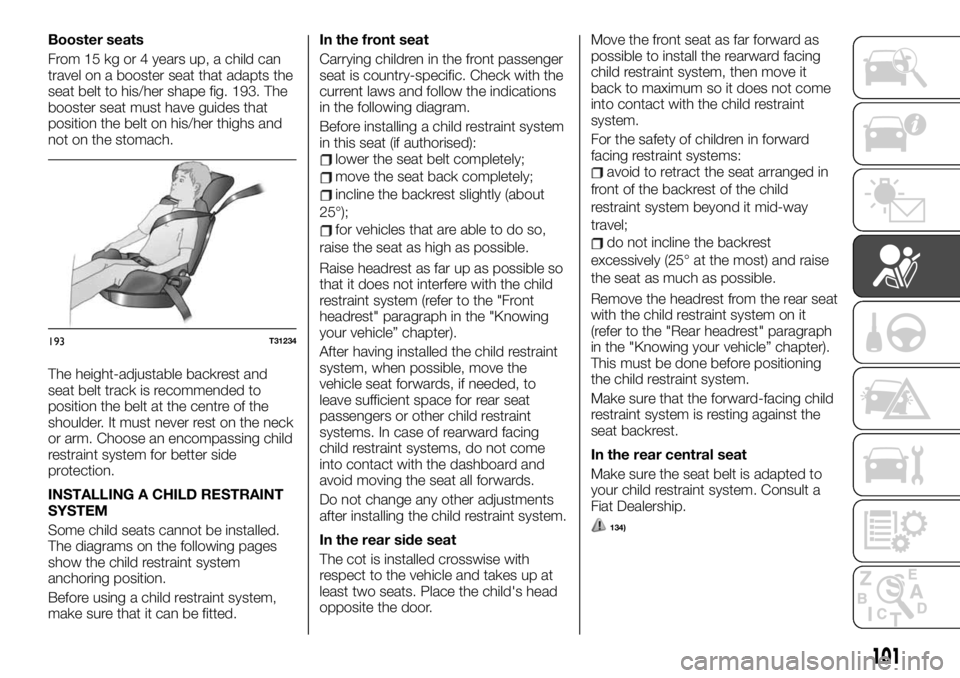
Booster seats
From 15 kg or 4 years up, a child can
travel on a booster seat that adapts the
seat belt to his/her shape fig. 193. The
booster seat must have guides that
position the belt on his/her thighs and
not on the stomach.
The height-adjustable backrest and
seat belt track is recommended to
position the belt at the centre of the
shoulder. It must never rest on the neck
or arm. Choose an encompassing child
restraint system for better side
protection.
INSTALLING A CHILD RESTRAINT
SYSTEM
Some child seats cannot be installed.
The diagrams on the following pages
show the child restraint system
anchoring position.
Before using a child restraint system,
make sure that it can be fitted.In the front seat
Carrying children in the front passenger
seat is country-specific. Check with the
current laws and follow the indications
in the following diagram.
Before installing a child restraint system
in this seat (if authorised):
lower the seat belt completely;
move the seat back completely;
incline the backrest slightly (about
25°);
for vehicles that are able to do so,
raise the seat as high as possible.
Raise headrest as far up as possible so
that it does not interfere with the child
restraint system (refer to the "Front
headrest" paragraph in the "Knowing
your vehicle” chapter).
After having installed the child restraint
system, when possible, move the
vehicle seat forwards, if needed, to
leave sufficient space for rear seat
passengers or other child restraint
systems. In case of rearward facing
child restraint systems, do not come
into contact with the dashboard and
avoid moving the seat all forwards.
Do not change any other adjustments
after installing the child restraint system.
In the rear side seat
The cot is installed crosswise with
respect to the vehicle and takes up at
least two seats. Place the child's head
opposite the door.Move the front seat as far forward as
possible to install the rearward facing
child restraint system, then move it
back to maximum so it does not come
into contact with the child restraint
system.
For the safety of children in forward
facing restraint systems:
avoid to retract the seat arranged in
front of the backrest of the child
restraint system beyond it mid-way
travel;
do not incline the backrest
excessively (25° at the most) and raise
the seat as much as possible.
Remove the headrest from the rear seat
with the child restraint system on it
(refer to the "Rear headrest" paragraph
in the "Knowing your vehicle” chapter).
This must be done before positioning
the child restraint system.
Make sure that the forward-facing child
restraint system is resting against the
seat backrest.
In the rear central seat
Make sure the seat belt is adapted to
your child restraint system. Consult a
Fiat Dealership.
134)
193T31234
101
Page 107 of 236
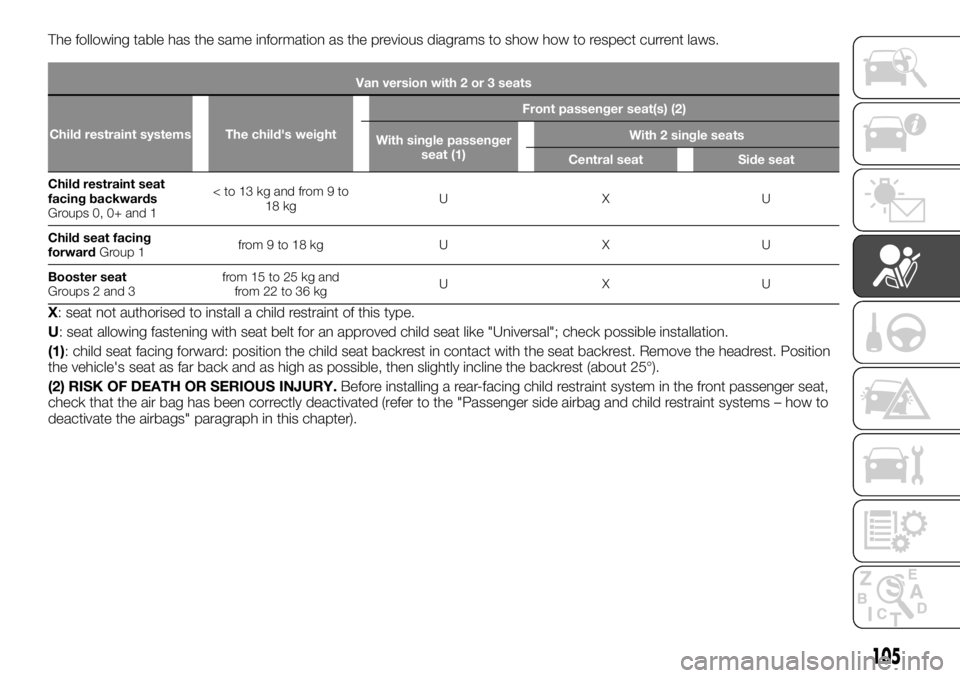
The following table has the same information as the previous diagrams to show how to respect current laws.
Van version with 2 or 3 seats
Child restraint systems The child's weightFront passenger seat(s) (2)
With single passenger
seat (1)With 2 single seats
Central seat Side seat
Child restraint seat
facing backwards
Groups 0, 0+ and 1
Child seat facing
forwardGroup 1from9to18kg U X U
Booster seatfrom 15 to 25 kg and
from 22 to 36 kgUXU
X: seat not authorised to install a child restraint of this type.
U: seat allowing fastening with seat belt for an approved child seat like "Universal"; check possible installation.
(1): child seat facing forward: position the child seat backrest in contact with the seat backrest. Remove the headrest. Position
the vehicle's seat as far back and as high as possible, then slightly incline the backrest (about 25°).
(2) RISK OF DEATH OR SERIOUS INJURY.Before installing a rear-facing child restraint system in the front passenger seat,
check that the air bag has been correctly deactivated (refer to the "Passenger side airbag and child restraint systems – how to
deactivate the airbags" paragraph in this chapter).
105
Groups 2 and 3
Page 109 of 236
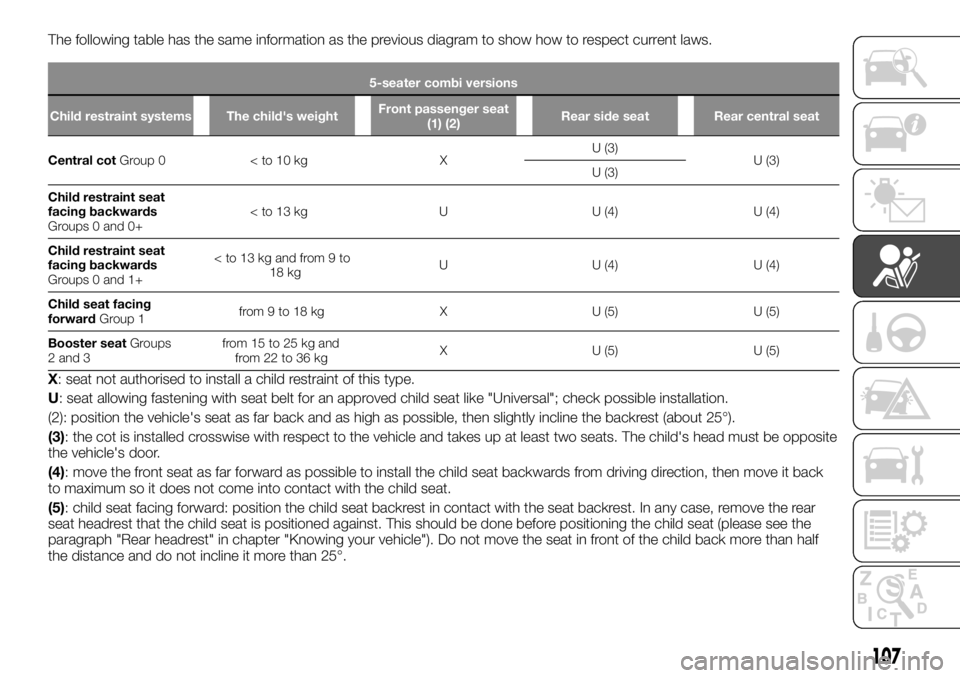
The following table has the same information as the previous diagram to show how to respect current laws.
5-seater combi versions
Child restraint systems The child's weightFront passenger seat
(1) (2)Rear side seat Rear central seat
Central cotGroup 0 < to 10 kg XU (3)
U (3)
U (3)
Child restraint seat
facing backwards
Groups 0 and 0+
facing backwards
Groups 0 and 1+
Child seat facing
forwardGroup 1from9to18kg X U(5) U(5)
Booster seatGroups
2 and 3from 15 to 25 kg and
from 22 to 36 kgX U (5) U (5)
X: seat not authorised to install a child restraint of this type.
U: seat allowing fastening with seat belt for an approved child seat like "Universal"; check possible installation.
(2): position the vehicle's seat as far back and as high as possible, then slightly incline the backrest (about 25°).
(3): the cot is installed crosswise with respect to the vehicle and takes up at least two seats. The child's head must be opposite
the vehicle's door.
(4): move the front seat as far forward as possible to install the child seat backwards from driving direction, then move it back
to maximum so it does not come into contact with the child seat.
(5): child seat facing forward: position the child seat backrest in contact with the seat backrest. In any case, remove the rear
seat headrest that the child seat is positioned against. This should be done before positioning the child seat (please see the
paragraph "Rear headrest" in chapter "Knowing your vehicle"). Do not move the seat in front of the child back more than half
the distance and do not incline it more than 25°.
107
Page 111 of 236
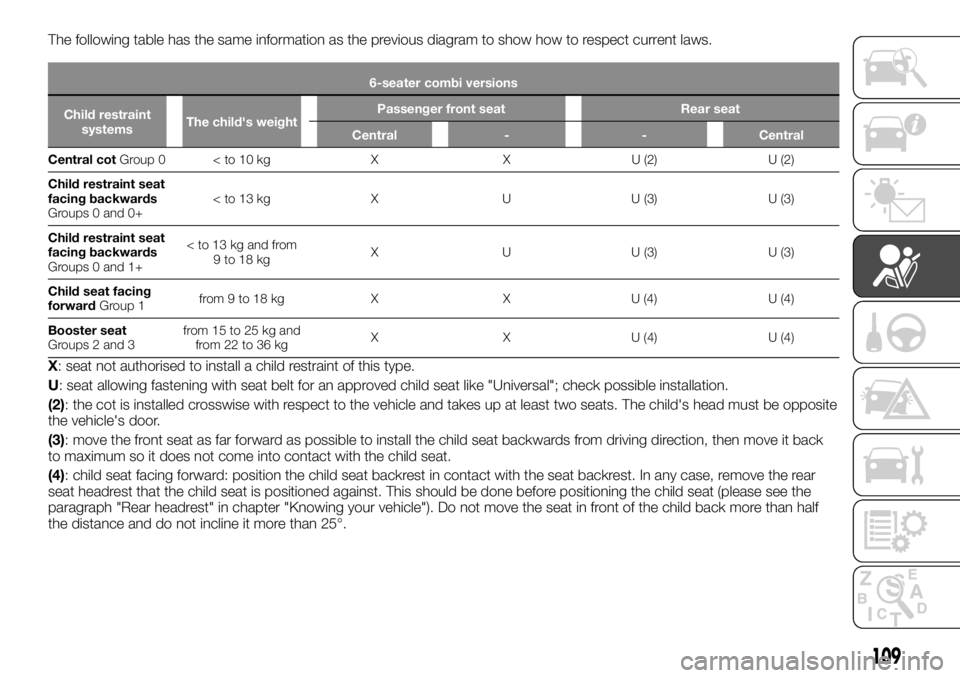
The following table has the same information as the previous diagram to show how to respect current laws.
6-seater combi versions
Child restraint
systemsThe child's weightPassenger front seat Rear seat
Central - - Central
Central cotGr
oup 0
facing backwards
Groups 0 and 0+
facing backwards
Groups 0 and 1+
Child seat facing
forwardGroup 1from 9 to 18 kg X X U (4) U (4)
Booster seat
Groups 2 and 3from 15 to 25 kg and
from 22 to 36 kgX X U (4) U (4)
X: seat not authorised to install a child restraint of this type.
U: seat allowing fastening with seat belt for an approved child seat like "Universal"; check possible installation.
(2): the cot is installed crosswise with respect to the vehicle and takes up at least two seats. The child's head must be opposite
the vehicle's door.
(3): move the front seat as far forward as possible to install the child seat backwards from driving direction, then move it back
to maximum so it does not come into contact with the child seat.
(4): child seat facing forward: position the child seat backrest in contact with the seat backrest. In any case, remove the rear
seat headrest that the child seat is positioned against. This should be done before positioning the child seat (please see the
paragraph "Rear headrest" in chapter "Knowing your vehicle"). Do not move the seat in front of the child back more than half
the distance and do not incline it more than 25°.
109
Page 113 of 236
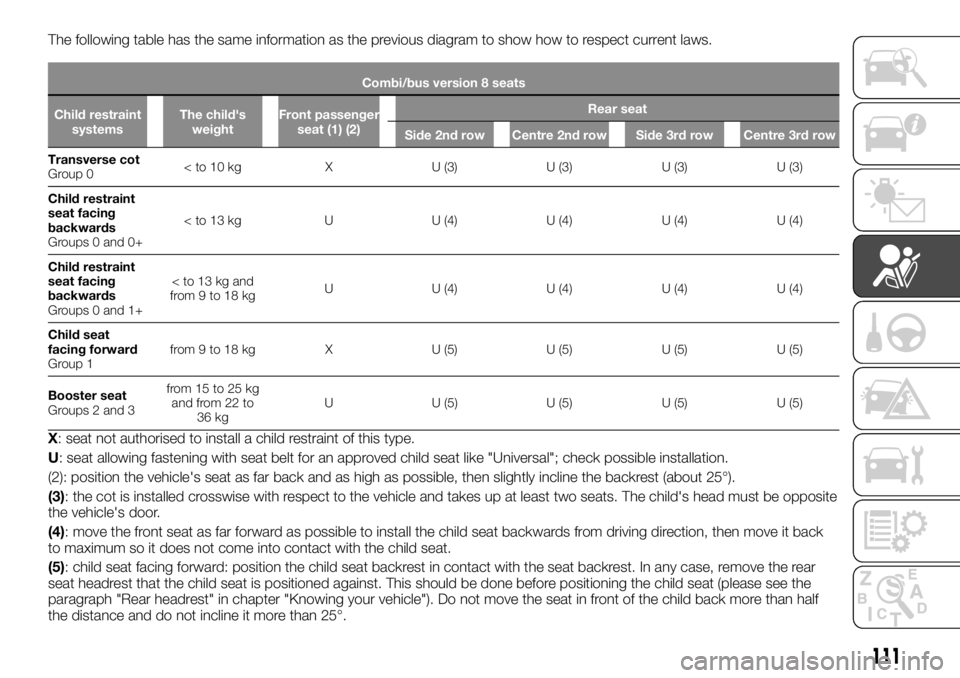
The following table has the same information as the previous diagram to show how to respect current laws.
Combi/bus version 8 seats
Child restraint
systemsThe child's
weightFront passenger
seat (1) (2)Rear seat
Side 2nd row Centre 2nd row Side 3rd row Centre 3rd row
Transverse cot
Gr
oup 0
seat facing
backwards
Groups 0 and 0+< to 13 kg U U (4) U (4) U (4) U (4)
Child restraint
seat facing
backwards
Groups 0 and 1+
Child seat
facing forward
Group 1from 9 to 18 kg X U (5) U (5) U (5) U (5)
Booster seat
Groups 2 and 3from 15 to 25 kg
and from 22 to
36 kgU U (5) U (5) U (5) U (5)
X: seat not authorised to install a child restraint of this type.
U: seat allowing fastening with seat belt for an approved child seat like "Universal"; check possible installation.
(2): position the vehicle's seat as far back and as high as possible, then slightly incline the backrest (about 25°).
(3): the cot is installed crosswise with respect to the vehicle and takes up at least two seats. The child's head must be opposite
the vehicle's door.
(4): move the front seat as far forward as possible to install the child seat backwards from driving direction, then move it back
to maximum so it does not come into contact with the child seat.
(5): child seat facing forward: position the child seat backrest in contact with the seat backrest. In any case, remove the rear
seat headrest that the child seat is positioned against. This should be done before positioning the child seat (please see the
paragraph "Rear headrest" in chapter "Knowing your vehicle"). Do not move the seat in front of the child back more than half
the distance and do not incline it more than 25°.
111
Page 115 of 236
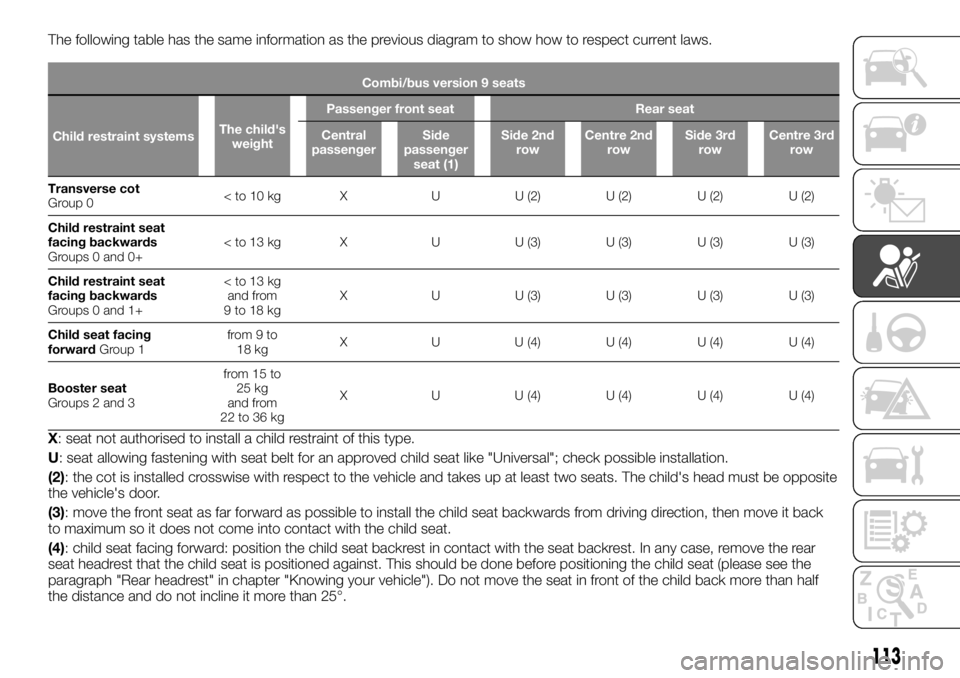
The following table has the same information as the previous diagram to show how to respect current laws.
Combi/bus version 9 seats
Child restraint systemsThe child's
weightPassenger front seat Rear seat
Central
passengerSide
passenger
seat (1)Side 2nd
rowCentre 2nd
rowSide 3rd
rowCentre 3rd
row
Transverse cot
Group 0
facing backwards
Groups 0 and 0+< to 13 kg X U U (3) U (3) U (3) U (3)
Child restraint seat
facing backwards
Groups 0 and 1+
9to18kgX U U (3) U (3) U (3) U (3)
Child seat facing
forwardGroup 1from 9 to
18 kgX U U (4) U (4) U (4) U (4)
Booster seat
Groups 2 and 3from 15 to
25 kg
and from
22 to 36 kgX U U (4) U (4) U (4) U (4)
X: seat not authorised to install a child restraint of this type.
U: seat allowing fastening with seat belt for an approved child seat like "Universal"; check possible installation.
(2): the cot is installed crosswise with respect to the vehicle and takes up at least two seats. The child's head must be opposite
the vehicle's door.
(3): move the front seat as far forward as possible to install the child seat backwards from driving direction, then move it back
to maximum so it does not come into contact with the child seat.
(4): child seat facing forward: position the child seat backrest in contact with the seat backrest. In any case, remove the rear
seat headrest that the child seat is positioned against. This should be done before positioning the child seat (please see the
paragraph "Rear headrest" in chapter "Knowing your vehicle"). Do not move the seat in front of the child back more than half
the distance and do not incline it more than 25°.
113